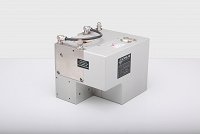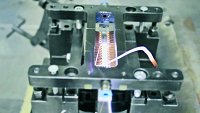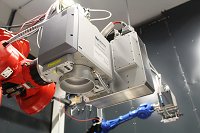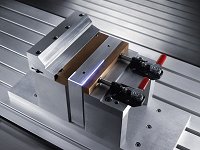Laser systems support breakthrough of e-mobility
17.10.2017
EVS30 (Electric Vehicle Symposium & Exhibition) was the industry get-together for the entire electromobility industry from 9 to 11 October 2017. Manufacturers, users and decision-makers obtained an up-to-date picture of all types of electric mobility and discussed the latest trends as well as applications of the electric drive train. The event in Stuttgart showed the direction in which electric mobility is heading and left no room for doubt that the demand for electric vehicles in Europe will continue to grow. Thanks to new and improved efficient production processes, laser systems make an important contribution and thus support the breakthrough of e-mobility. This will also be reflected at LASYS 2018 from 5 to 7 June 2018. Many experienced exhibitors and experts will share their knowledge here through innovations and solutions.
The international trade fair for laser material processing in Stuttgart has become the most important industry get-together for laser system providers, integrators, service providers and laser users from industry. LASYS 2018 takes place for the sixth time with around 200 exhibitors. Owing to its broad user orientation, the trade fair appeals to both machine and motor vehicle construction, the electrical and electronics industry, the optical industry, plant and apparatus construction, the metalworking and metal-processing industry, medical technology, the plastics industry, toolmaking and mouldmaking, as well as the semiconductor industry and many other sectors.
High flexibility and productivity with use of laser systems
 Motor vehicle construction has always been a forerunner in the use of laser systems. Electric vehicles and their acceptance are a current trend topic. The focus here is on increasing performance and lowering costs. Marc Kirchhoff, Head of Automotive Industry Management at Trumpf, sees the development of production capacities to the automotive scale , i.e. high volumes, as one of the big challenges in this regard. "Laser is the ideal tool here based on its high level of productivity and flexibility", he adds. "The use of laser extends across the entire process chain of electric car production", states Dr. Jens Standfuss, Head of the Joining Business Segment at the Fraunhofer Institute for Material and Beam Technology (IWS) in Dresden, "no matter whether it concerns battery manufacturing, electrical contacting, connections or the drive train – i.e. the power electronics and electric motor." IWS and Trumpf will be present at LASYS 2018 as exhibitors.
Motor vehicle construction has always been a forerunner in the use of laser systems. Electric vehicles and their acceptance are a current trend topic. The focus here is on increasing performance and lowering costs. Marc Kirchhoff, Head of Automotive Industry Management at Trumpf, sees the development of production capacities to the automotive scale , i.e. high volumes, as one of the big challenges in this regard. "Laser is the ideal tool here based on its high level of productivity and flexibility", he adds. "The use of laser extends across the entire process chain of electric car production", states Dr. Jens Standfuss, Head of the Joining Business Segment at the Fraunhofer Institute for Material and Beam Technology (IWS) in Dresden, "no matter whether it concerns battery manufacturing, electrical contacting, connections or the drive train – i.e. the power electronics and electric motor." IWS and Trumpf will be present at LASYS 2018 as exhibitors.
Making batteries even more efficient with surface structuring
Laser has come to be indispensable in the manufacture of batteries. The IWS is conducting research on the second generation of battery cells, among other things. "With laser we improve the surface properties of electrode materials via direct structuring processes or interference methods. In this way structures can be produced on a micrometre or submicrometre scale depending on the wavelength and pulse energy. In association with optimised coating systems and the cell chemistry, we can ultimately increase the gravimetric energy density and lower material costs", explains Dr. Standfuss. This means the battery becomes more efficient and longer distances can be covered with the electric car. E-mobility therefore becomes more attractive for drivers.
Scanners and image sensors make possible lean production stations
 There are even more process steps that laser can master in battery production. Trumpf expert Kirchhoff reports: "Lasers can be used to weld the frame surrounding the battery cell pack with low distortion and are therefore advantageous for the heat transfer. Lasers are now the standard tool to weld prismatic battery cells and to subsequently contact these cells on a modular level." Thibault Bautze, Head of Technical Sales at Blackbird Robotics, states: "Especially in the area of electric mobility a firmly bonded connection of different materials, such as copper and aluminium, is interesting as a substitute for mechanically joined connections in a variety of applications." Instead of a screw connection, the aluminium electrode is now welded to the copper arrestor. "Thanks to the excellent focusable laser", adds Bautze, "the power for fusing can be introduced to the component at a very high power density." The welding seam can therefore be positioned very accurately.
There are even more process steps that laser can master in battery production. Trumpf expert Kirchhoff reports: "Lasers can be used to weld the frame surrounding the battery cell pack with low distortion and are therefore advantageous for the heat transfer. Lasers are now the standard tool to weld prismatic battery cells and to subsequently contact these cells on a modular level." Thibault Bautze, Head of Technical Sales at Blackbird Robotics, states: "Especially in the area of electric mobility a firmly bonded connection of different materials, such as copper and aluminium, is interesting as a substitute for mechanically joined connections in a variety of applications." Instead of a screw connection, the aluminium electrode is now welded to the copper arrestor. "Thanks to the excellent focusable laser", adds Bautze, "the power for fusing can be introduced to the component at a very high power density." The welding seam can therefore be positioned very accurately.
On the one hand this enables the processing of very small components, and on the other hand according to the Blackbird expert a distance to heat-sensitive materials such as plastics can be observed. "Advantages include improved electrical conductivity of the contacting, uniform heat transfer and higher mechanical strength", explains Bautze. He adds: "With this material mix the laser can demonstrate its true benefit in laser welding, especially in conjunction with a scanner. In combination with image sensors for component position detection, very short cycle times and lean production stations are possible, something that cannot be achieved with conventional joining methods." The experts from Blackbird Robotics are also happy to help LASYS visitors with their exhibits and share their know-how.
Aluminium and copper challenge laser systems
 Aluminium and copper are materials that reflect light very differently. This is why manufacturers are particularly challenged to develop laser systems that efficiently introduce photon energy to the material. "Together with beam source manufacturers we are testing lasers that work in the green and blue wavelength spectrum", states Dr. Standfuss. Trumpf expert Kirchhoff notes: "New beam formation concepts or modified wavelengths such as green laser light also significantly reduce the amount of splashes when welding copper components."
Aluminium and copper are materials that reflect light very differently. This is why manufacturers are particularly challenged to develop laser systems that efficiently introduce photon energy to the material. "Together with beam source manufacturers we are testing lasers that work in the green and blue wavelength spectrum", states Dr. Standfuss. Trumpf expert Kirchhoff notes: "New beam formation concepts or modified wavelengths such as green laser light also significantly reduce the amount of splashes when welding copper components."
Lightweight construction benefits from versatility of laser
For a few years now everyone has been talking about lightweight construction when it comes to automotive production. It also plays an important role in electric cars. "The high weight of the battery element should be compensated by a lightweight construction and the drive power required should also be reduced. This is where laser can be used for joining and cutting new types of material for lightweight construction", highlights Georg Hofner, Spokesman of the Management Board of SCANLAB. But he also sees other laser applications such as component cleaning before bonding or welding and also hardening of components. "This versatility of laser is imperative for future lightweight materials in order to be able to manufacture efficiently", adds Hofner. As an exhibitor of LASYS 2018, SCANLAB will also help trade fair visitors to find solutions with their innovations and expert knowledge.
Increase efficiency of electric motor with laser
 Laser will play a key role in the manufacture of electric motors now and in the future. Kirchhoff adds: "Lasers are already used to weld hair pins in electric drives remotely, contactless – and thanks to image processing with high-precision." New developments currently in progress in the automotive industry involve, for example, the electrical sheets for the rotors. The IWS is also involved in this area: "Firstly, panels can be cut much more favourably with lasers", explains Dr. Standfuss, "and secondly the electromagnetic losses can be reduced. The cutting speeds with lasers are so high that ultimately the affected zone along the cutting edge is much smaller than is the case with mechanical punching processes. This affects the hysteresis losses and the electrical efficiency of the motor." More efficient motors can also be built in the future with optimized fin geometry and targeted laser structuring for improving the electromagnetic behaviour. Laser systems are freely programmable as far as the cutting geometry of fins is concerned. According to the researcher, the topic of quality and costs plays a major role especially in the initial phase of a new product range. "A punching tool is associated with a lot of effort and expense which then has to be allocated to the number of products. The flexibility of laser will certainly also pay off here in the future", summarises Dr. Jens Standfuss. E-mobility is also an important growth driver for laser applications.
Laser will play a key role in the manufacture of electric motors now and in the future. Kirchhoff adds: "Lasers are already used to weld hair pins in electric drives remotely, contactless – and thanks to image processing with high-precision." New developments currently in progress in the automotive industry involve, for example, the electrical sheets for the rotors. The IWS is also involved in this area: "Firstly, panels can be cut much more favourably with lasers", explains Dr. Standfuss, "and secondly the electromagnetic losses can be reduced. The cutting speeds with lasers are so high that ultimately the affected zone along the cutting edge is much smaller than is the case with mechanical punching processes. This affects the hysteresis losses and the electrical efficiency of the motor." More efficient motors can also be built in the future with optimized fin geometry and targeted laser structuring for improving the electromagnetic behaviour. Laser systems are freely programmable as far as the cutting geometry of fins is concerned. According to the researcher, the topic of quality and costs plays a major role especially in the initial phase of a new product range. "A punching tool is associated with a lot of effort and expense which then has to be allocated to the number of products. The flexibility of laser will certainly also pay off here in the future", summarises Dr. Jens Standfuss. E-mobility is also an important growth driver for laser applications.
First-class accompanying programme
The next LASYS promises to be very interesting. Visitors can expect to see all facets of laser material processing on the trade fair grounds in Stuttgart. And the practical, high-ranking accompanying programme to LASYS 2018, such as the Stuttgart Laser Technology Forum (SLT), the "Lasers in Action" forum or the "Stuttgart Laser Marketplace", provide a platform for the international exchange of information and ideas at the highest level. Another good reason to come to Stuttgart in June 2018.




































